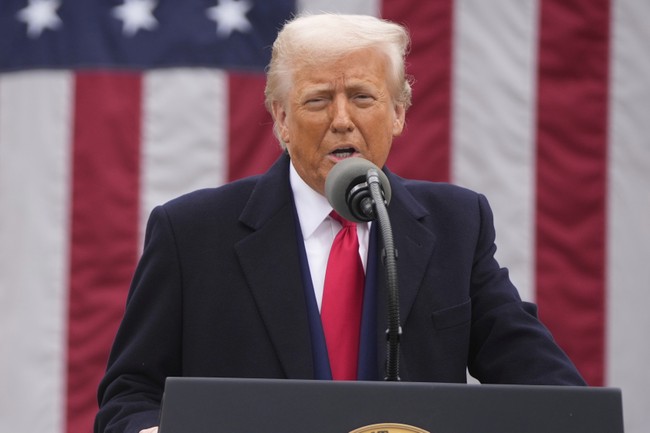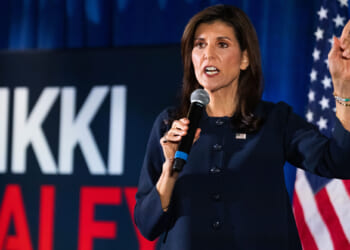
The past week has reminded everyone about two sure-fire ways to lose money in the stock market: Buying … and selling. That’s even more true when doing either in a panic. And that’s especially true when using the stock market as a casino rather than as a vehicle for long-term investment.
After a weekend of predictions of a “Black Monday,” the markets actually remained relatively stable. And today, all three American indices roared back, making up 1,000 or more points at the open today on the Dow Jones Industrial Index. That mirrored rebounds around the world, the Wall Street Journal reported, despite China’s vow to escalate the trade war with the US — mainly because the Trump administration appears to have adjusted its message:
Investors took heart from signs the U.S. could strike deals with major trading partners, even after Beijing said it was prepared for a prolonged battle over tariffs.
U.S. indexes advanced more than 3% shortly after the open, with the Dow industrials rising 1200 points. Treasury Secretary Scott Bessent said the Trump administration was open to negotiating to reduce tariffs, saying the U.S. could “end up with some good deals.”
That is indeed a new message. Over the weekend, Donald Trump’s trade adviser Peter Navarro insisted that the tariffs would not be a vehicle for negotiation, but were a policy designed for broader purposes. But by yesterday, even Navarro sensed that the administration needed to do a better job selling the tariff regimes:
“And it’s going to happen, Dow 50,000, I guarantee that, and I guarantee no recession, okay? Why? Because when we pass the biggest, broadest tax cut in history within a matter of months, that’s going to be a great stimulus,” he said Monday during an appearance on Fox News’s “The Ingraham Angle.”
“There’s not going to be any inflation,” Navarro told host Laura Ingraham. “We’ve already had a significant drop, a huge drop in oil prices, Laura. That’s like a point off the CPI. We’re going to have lower yields and mortgage.”
His comments come after Trump signaled openness on Monday to negotiating with other countries looking to soften the blow of the new tariffs.
Trump called attention to the offers coming his way after “Liberation Day,” and hinted that he’s open for negotiations — as long as markets truly open:
President Trump hit back hard against China but left the door open for talks to lower tariffs on other countries, trade-war moves that left much of the world confused as countries raced to avoid damaging new duties on their goods.
“They can both be true,” Trump said Monday when asked whether the tariffs are permanent or up for negotiation.
Trump’s comments leave countries and industries to fend for themselves ahead of his self-imposed deadline Wednesday for imposing steep duties on nations such as China, Japan and Vietnam. More than 50 countries have reached out to the White House in recent days to try to cut a deal with Trump, officials said, putting the president in the middle of a global rush to placate him. …
“They’re offering things to us that we would have never even thought of asking them for,” he said of foreign countries, adding: “Nobody but me would do this.”
That much is certainly true. Today’s rebound — and yesterday’s pause — comes as a response to these hints that Trump wants to reset the negotiating table dramatically in favor of the US. It may reflect a new estimation that the tariff terms Trump announced may not have been intended as a final product. It would be the international-trade version of Salena Zito’s famous warning to take Trump seriously rather than literally.
Still, some are taking Trump literally and arguing to give tariffs a chance to work as Trump intends. Oren Cass makes that case today, surprisingly in the New York Times, cautioning against panic while Trump reorients the American economy toward re-industrialization. But Cass also warns Trump to treat allies with care and to prepare America to fulfill the role he sees:
So what is the goal? Based on the administration’s public remarks, it is to eliminate large trade imbalances within a U.S.-led bloc that excludes China, other nonmarket economies and any country determined to continue running large surpluses at the expense of its partners. In remarks on Monday, Stephen Miran, the head of the White House Council of Economic Advisers, emphasized that the administration also sees security commitments as indelibly tied to economic ones.
If those are the contours, Mr. Trump should say so, outline the kinds of concessions he expects from allies seeking to rebalance trade and detail the common policies toward China that all members of the bloc must adopt. (Mr. Miran’s remarks, which answered the question “what forms can that burden sharing take?” with five different suggestions, were an important step in the right direction.) Then the president can sit back and await best offers. Thanks to early actions against our closest neighbors, renegotiation of the United States-Mexico-Canada Agreement will begin soon. A successful new deal would establish a strong North American core for any future bloc and signal clearly what the United States expects from others.
Finally, Mr. Trump’s administration needs to get serious about other policies necessary to support reindustrialization. If the United States is going to reduce its trade deficit quickly without painful cuts to domestic consumption, it’s going to have to increase production capacity just as quickly, either to expand exports to other markets or to substitute for imports at home. This requires industrial policy akin to what the CHIPS and Science Act has already achieved for semiconductor manufacturing, with help from new forms of public financing and accelerated permitting. New infrastructure will have to be built and new sources of energy brought online. Perhaps most critically, enormous resources must be poured into work force development.
Cass’ essay is well worth reading in full. The chaos of “Liberation Day” has made its point; now is the time for rational policies in pursuit of rational objectives. If tariffs will work as Trump foresees, then they have to be scaled properly and be predictable enough to have investors putting their money at risk to support the capital investments re-industrialization will require. Having investors flee to bonds doesn’t advance the ball.
I’m still skeptical about tariffs as a net positive. It’s true that our trading partners have gotten away with tariffs on American goods and other restrictions to markets for our exports, but the long-term objective should be trade that is both free and fair, not one or the other. Trump should be given the chance to make those policies work, but to get that benefit of the doubt, Trump and his team have to start acting in ways that support trust rather than panic. The last two days appear to be a step in the right direction, and that’s why the markets appear to be recovering lost ground with investors.












